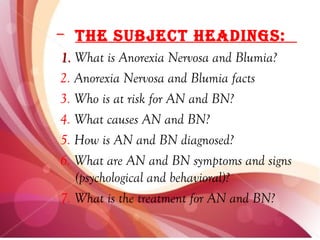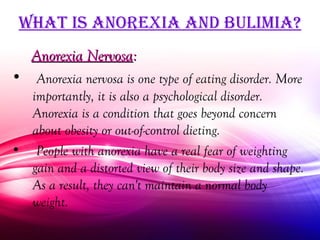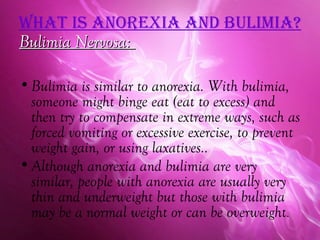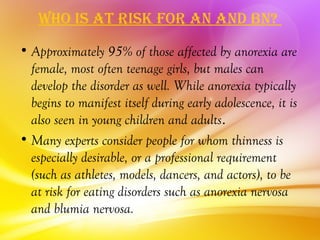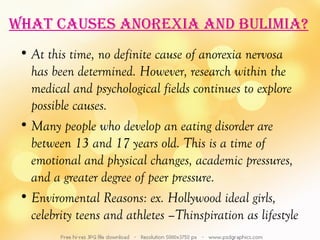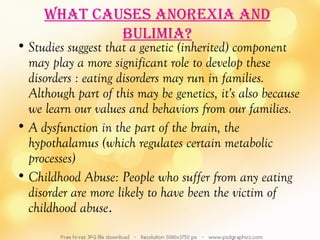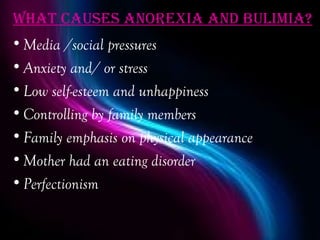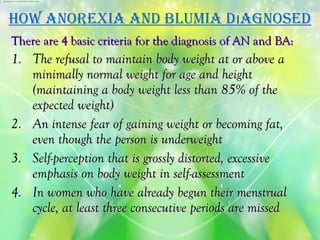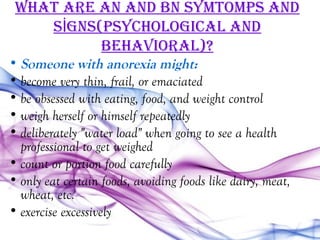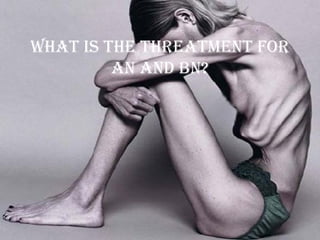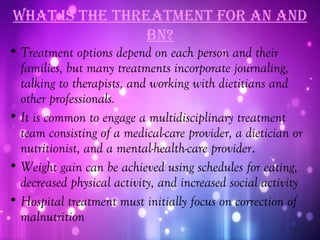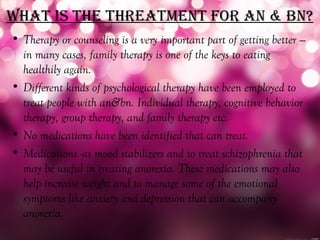Anorexia Nervosa and Bulimia Nervosa
- 1. and BULIMIA NERVOSA Ayşe Betül KILIÇ
- 2. – The SubjecT headingS: 1. What is Anorexia Nervosa and Blumia? 2. Anorexia Nervosa and Blumia facts 3. Who is at risk for AN and BN? 4. What causes AN and BN? 5. How is AN and BN diagnosed? 6. What are AN and BN symptoms and signs (psychological and behavioral)? 7. What is the treatment for AN and BN?
- 3. WhaT iS anorexia and bulimia? Anorexia Nervosa: • Anorexia nervosa is one type of eating disorder. More importantly, it is also a psychological disorder. Anorexia is a condition that goes beyond concern about obesity or out-of-control dieting. • People with anorexia have a real fear of weighting gain and a distorted view of their body size and shape. As a result, they can't maintain a normal body weight.
- 4. WhaT iS anorexia and bulimia? Bulimia Nervosa: • Bulimia is similar to anorexia. With bulimia, someone might binge eat (eat to excess) and then try to compensate in extreme ways, such as forced vomiting or excessive exercise, to prevent weight gain, or using laxatives.. • Although anorexia and bulimia are very similar, people with anorexia are usually very thin and underweight but those with bulimia may be a normal weight or can be overweight.
- 5. WhY Would a PerSon binge? • To fill a void inside • To hide negative emotions • To cope with daily stresses and problems WhY Would a PerSon Purge? • Because of guilt and depression of having binged.
- 6. anorexia and bulimia facTS • The cause of AN and BN have not been definitively established, but self-esteem and self-image issues, societal pressures, and genetic factors likely each play a role. • AN and BN affect females far more often than males and is most common in adolescent females. • People with AN and BN tend to show compulsive behaviors, may become obsessed with food. • About 1000 people are dying every year because of an eating disorder
- 7. Who iS aT riSk for an and bn? • Approximately 95% of those affected by anorexia are female, most often teenage girls, but males can develop the disorder as well. While anorexia typically begins to manifest itself during early adolescence, it is also seen in young children and adults. • Many experts consider people for whom thinness is especially desirable, or a professional requirement (such as athletes, models, dancers, and actors), to be at risk for eating disorders such as anorexia nervosa and blumia nervosa.
- 8. WhaT cauSeS anorexia and bulimia?
- 9. WhaT cauSeS anorexia and bulimia? • At this time, no definite cause of anorexia nervosa has been determined. However, research within the medical and psychological fields continues to explore possible causes. • Many people who develop an eating disorder are between 13 and 17 years old. This is a time of emotional and physical changes, academic pressures, and a greater degree of peer pressure. • Enviromental Reasons: ex. Hollywood ideal girls, celebrity teens and athletes –Thinspiration as lifestyle
- 10. WhaT cauSeS anorexia and bulimia? • Studies suggest that a genetic (inherited) component may play a more significant role to develop these disorders : eating disorders may run in families. Although part of this may be genetics, it's also because we learn our values and behaviors from our families. • A dysfunction in the part of the brain, the hypothalamus (which regulates certain metabolic processes) • Childhood Abuse: People who suffer from any eating disorder are more likely to have been the victim of childhood abuse.
- 11. WhaT cauSeS anorexia and bulimia? • Media /social pressures • Anxiety and/ or stress • Low self-esteem and unhappiness • Controlling by family members • Family emphasis on physical appearance • Mother had an eating disorder • Perfectionism
- 12. hoW anorexia and bulimia dıagnoSed? • Anorexia and bulimia can be a difficult disorder to diagnose, since individuals with anorexia or bulimia often attempt to hide the disorder. • Denial and secrecy frequently accompany other symptoms. • It is unusual for an individual with anorexia to seek professional help because the individual typically does not accept that she or he has a problem. • In many cases, the actual diagnosis is not made until medical complications have developed
- 13. hoW anorexia and bulimia dıagnoSed? • The individual is often brought to the attention of a professional by family members only after marked weight loss has occurred. • They often lack insight into their problem despite being severely malnourished and may be unreliable in terms of providing accurate information. • Therefore, it is often necessary to obtain information from parents, a spouse, or other family members in order to evaluate the degree of weight loss and extent of the disorder
- 14. hoW anorexia and blumia dıagnoSed There are 4 basic criteria for the diagnosis of AN and BA: 1. The refusal to maintain body weight at or above a minimally normal weight for age and height (maintaining a body weight less than 85% of the expected weight) 2. An intense fear of gaining weight or becoming fat, even though the person is underweight 3. Self-perception that is grossly distorted, excessive emphasis on body weight in self-assessment 4. In women who have already begun their menstrual cycle, at least three consecutive periods are missed
- 16. WhaT are an and bn SYmTomPS and SİgnS(PSYchological and behaVioral)? • Someone with anorexia might: • become very thin, frail, or emaciated • be obsessed with eating, food, and weight control • weigh herself or himself repeatedly • deliberately "water load" when going to see a health professional to get weighed • count or portion food carefully • only eat certain foods, avoiding foods like dairy, meat, wheat, etc. • exercise excessively
- 17. WhaT are an and bn SYmTomPS and SİgnS(PSYchological and behaVioral)? • Someone with anorexia might: • feel fat • withdraw from social activities, especially meals and celebrations involving food • be depressed, lethargic (lacking in energy), and feel cold a lot • Denial of hunger • Not eating in front of others • Skips meals by making up excuses
- 18. WhaT are an and bn SYmTomPS and SİgnS(PSYchological and behaVioral)? • Someone with bulimia might: • fear weight gain • be intensely unhappy with body size, shape, and weight • make excuses to go to the bathroom immediately after meals • only eat diet or low-fat foods (except during binges) • regularly buy laxatives, diuretics, or enemas • spend most of his or her time working out or trying to work off calories
- 21. WhaT iS The ThreaTmenT for an and bn?
- 22. WhaT iS The ThreaTmenT for an and bn? • Treatment options depend on each person and their families, but many treatments incorporate journaling, talking to therapists, and working with dietitians and other professionals. • It is common to engage a multidisciplinary treatment team consisting of a medical-care provider, a dietician or nutritionist, and a mental-health-care provider. • Weight gain can be achieved using schedules for eating, decreased physical activity, and increased social activity • Hospital treatment must initially focus on correction of malnutrition
- 23. WhaT iS The ThreaTmenT for an & bn? • Therapy or counseling is a very important part of getting better — in many cases, family therapy is one of the keys to eating healthily again. • Different kinds of psychological therapy have been employed to treat people with an&bn. Individual therapy, cognitive behavior therapy, group therapy, and family therapy etc. • No medications have been identified that can treat. • Medications -as mood stabilizers and to treat schizophrenia that may be useful in treating anorexia. These medications may also help increase weight and to manage some of the emotional symptoms like anxiety and depression that can accompany anorexia.
- 25. Thank you for your attention... Ay ş e Betül Kılıç

